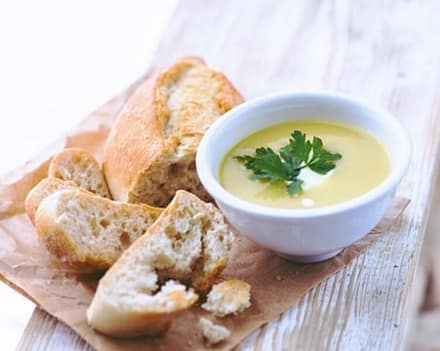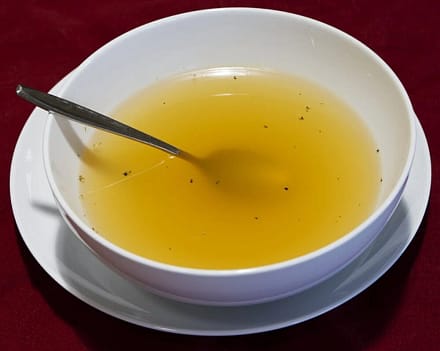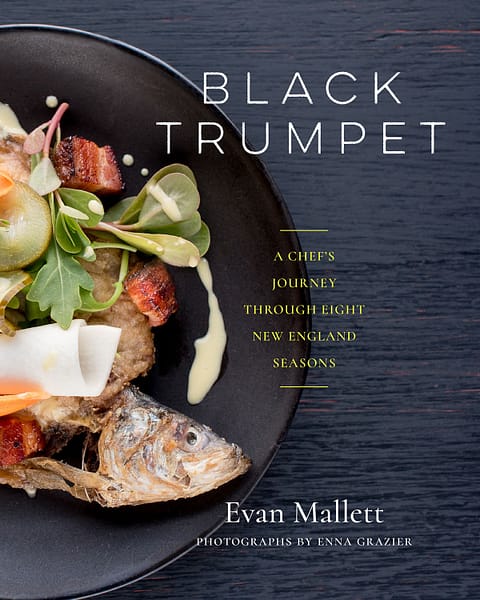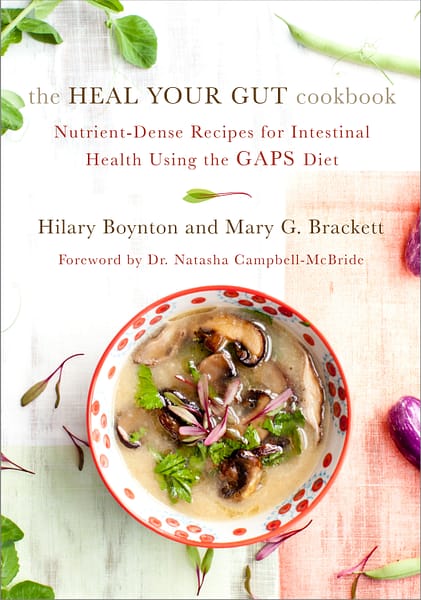The Fundamentals of Stocks and Broths

Soup season is finally here! While the weather is getting colder, stocks and broths warm our bellies and fill our souls.
Get started on your own classic stock this winter with help from this culinary insight and advice!
The following is an excerpt from Mastering Stocks and Broths by Rachael Mamane. It has been adapted for the web.
Stocks: The Fundamentals
At the highest level, classic culinary stocks can be categorized into four types: meat, poultry, fish, and vegetable. The French refer to stocks as the fond, or base, by which the foundation of a dish is developed. From here, technique determines the depth of flavor and color your stock will exhibit: The decision to blanch or roast bones, or sauté or roast vegetables, establishes the purpose of the stock in your final dishes—whether to be prominent or to blend in the background.
Types of Stocks
All stocks have the addition of mirepoix and other aromatics in common, which mellows the forward flavors of the main ingredient and brings a stock to a balanced state. As you become proficient with the technique, considering the purpose of the stock before making it will become an ingrained part of the process.
After a stock is made, you can adjust its clarity and concentration to achieve other fundamental states. We’ll review the main stock types below, as well as their derivatives, before digging deep into each category in subsequent chapters.
 White Stocks
White Stocks
A white stock, or fond blanc, is light in color and silky in texture. It is made by cleaning bones to remove impurities without adding color. Sometimes bones are clean enough to require only a thorough rinse, though most bones need to be blanched to achieve purity.
The bones often used are full of collagen—such as veal bones for a white veal stock or supplemental chicken feet for a white chicken stock—and result in a gelatinous finish. A mirepoix of common vegetables—either raw, or lightly sautéed—is introduced to the liquid in order to maintain a delicate hue in the finished stock.
Cooking With White Stocks
Due to their light color, white stocks are commonly used as a neutral cooking component. They can blend with, rather than overpower, the ingredients of a dish, allowing a main ingredient to remain the feature. White stocks are also great for adding liquid to, or finishing a dish; a splash of a gelatinous stock will bring ingredients together in the pan, making it ideal for risotto or other grain dishes.
With their silken texture, white stocks are an excellent foundation for soups or other dishes where a well-developed broth is essential. White stocks also make an ideal poaching liquid, which can be stored after use as a compound stock, also known as a double stock.
In classic French texts, fond blanc typically refers to poultry stocks, but has come to mean any stock made with ingredients that have not been roasted for color, including all types of animals and vegetables.
Brown Stocks
A brown stock, or fond brun, is rich in color—ranging from a golden brown to a deep mahogany—and full in body. It is made by roasting bones, and often vegetables, which add a caramelized flavor to the stock. For some brown stocks, tomato paste is roasted with the bones or folded into the stock to brighten the hue and further develop texture. In the case of lamb and duck stocks, the vegetables are sautéed instead of roasted; this variation prevents the liquid from becoming too dark.
With their rich, dark shade, brown stocks are intended to guide the flavor and texture of a dish. They can be featured in a stew or served as a rich soup base, where the broth is a main ingredient. Roasted stocks are often used for braising meat and vegetables; the braising liquid can be strained and reduced at the end to make a velvety sauce for the dish.
Reducing Brown Stocks
This reduction step applies to brown stocks as well, not just braising liquids: After straining, the stock can be significantly reduced to make a glace de viande, or meat glaze. This process further concentrates flavor—it’s reduced about eight to ten times, and a little goes a long way. A small scoop is the ideal base for gravies and sauces.
In classic French texts, fond brun most commonly refers to veal stocks, but has come to mean any stock made with ingredients that have been roasted for color. As with white stocks, this expansion includes all manner of animals and vegetables.
 Fish Stocks
Fish Stocks
Similar to all animal-based stocks, fish stock is made by simmering meaty fish bones that have been leached, blanched, or roasted with aromatics. Fish bones, however, impart a unique quality to liquid—both piscine and briny—unlike the characteristics gleaned from any land animal.
The French refer to fish stock as fumet, which commonly contains white wine and is reduced to concentrate the flavors. Stocks made from shellfish are also included in this category.
What Is Used to Make Fish Stocks?
Classically, fish stock is made from the bones of neutral flatfish, such as halibut, flounder, or sole, and comes together in the pot in less than an hour. Any more time, and the stock will develop a bitter taste. In contemporary cooking, it is acceptable to use the bones from white bony fish, such as snapper, grouper, and cod.
These varieties can withstand a longer simmering time, and the cartilage in the bones breaks down to develop a gelatinous base. I enjoy incorporating monkfish tail for its delicate flavor and adding a small amount of skate wing or fish collars when a thick-bodied stock is the goal. Fish heads can also be used, provided the eyes and gills are removed before use.
Fish Stocks & Aromatics
Aromatics play a versatile role in the making of fish stock. The buttery flavor and texture of leeks softens the intensity of the piscine flavor. Sometimes carrots are omitted from the aromatic base, in order to preserve a neutral color in the stock; parsnips can be a flavorful substitute that won’t alter the hue. Fennel is a superb match with seafood and is regularly featured in stock recipes. At times, it is further highlighted in finished dishes with a splash of an anise-based spirit. Similarly, tarragon, an herb with a subtle licorice aroma, lends itself well to shellfish stocks.
The Basics of Broths
Broth is a categorical derivative of stock, made by adding ingredients that go beyond the essence of its foundation. It can be seen as a fortified stock, enhanced with additional meat, aromatics, herbs, and spices. Broth is a developed part of the dish as opposed to a building block.
A broth can be the defining component of a recipe, as illustrated in Sea Bream à la Nage, where the poached fish “swims” in its broth on the plate. The process of building a broth invites unlimited creativity in the kitchen: It can be bold and flavorful, subtle and nuanced, or somewhere in between.
What Does Broth Mean?
Technically, broth also refers to a stock made with meat instead of bones. Since meat does not contain binding agents, such as collagen, it requires less simmering time than bones to extract its essence. As such, broths made with meat and no bones remain fluid due to the lack of gelatin content. An excellent example of a simple homemade broth is Classic Beef Tea, where a chunk of beef is steeped in hot water.
Though the USDA does not make a distinction between stock and broth, commercial containers labeled as broth are commonly made with trimmings from processed meats.
 Bone Broth
Bone Broth
Bone broths have recently emerged as a stand-alone category, referring to a gelatin-dense stock that is sipped like a broth. The goal of a bone broth is to render as much collagen into gelatin as possible in the simmering liquid, and also extract trace minerals.
There are many recipes for bone broth, and guidelines often contradict culinary intuition, such as length of time cooking and what constitutes a spent ingredient.
Bone Broth Recipes
Nevertheless, most bone broth recipes have three things in common: 1. They use meaty bones from parts of the animal that are rich in collagen. 2. Bones might be soaked in vinegar before simmering. 3. The mixture is simmered longer than a traditional stock. As such, the final broth is viscous, and according to some recipes, might be cloudy instead of clear.
Vegetable Stock
Vegetable stock is made by simmering raw or roasted vegetables with herbs and spices to develop a foundation that is light in flavor and body. It can be made with a mixture of vegetables, similar to those found in animal stocks, or it can feature one main ingredient, such as mushrooms or tomatoes, with other vegetables blending into the background.
Remouillage
A remouillage is a secondary stock made from bones that have already been simmered to make a primary stock. In French, the word remouillage means “rewetting”—here, a reference to the bones being submerged in water twice. It is also known as a second stock.
Demi-Glace
A demi-glace is a rich base made by combining and reducing brown stock and Espagnole sauce, a basic brown sauce, otherwise known as one of Escoffier’s classic mother sauces. A demi-glace, or “half glaze,” comes from the French word glace, which means “icing” or “glaze”; here, it refers to the glossy coating that a demi-glace develops when poured over meat or presented as a plated sauce.
Consommé
Consommé is a type of pure, flavorful soup or broth that has been clarified. It is a delicate offering, served hot or cold, and is considered to be a notable achievement for a chef.
Recommended Reads
Recent Articles
What’s so great about oyster mushrooms? First, you can add them to the list of foods that can be grown indoors! They are tasty, easy to grow, multiply fast, and they love a variety of substrates, making oyster mushrooms the premium choice. The following is an excerpt from Fresh Food from Small Spaces by R. J.…
Read MoreCraving something sweet? These delicious maple roasted nuts are the perfect treat to help you push through those end-of-winter blues. The following is an excerpt from Full Moon Feast by Jessica Prentice. It has been adapted for the web. The Magic of Maple: A Rich History Following the Hunger Moon, just before the first thaw…
Read MoreDoes the cold weather have you dreaming about fresh greens and colorful salad? Grow and harvest sprouts indoors to make those dreams a reality! Follow this quick start guide to year-round greens for fresh salad greens in just a couple of weeks! The following is an excerpt from Year-Round Indoor Salad Gardening by Peter Burke. It…
Read More











